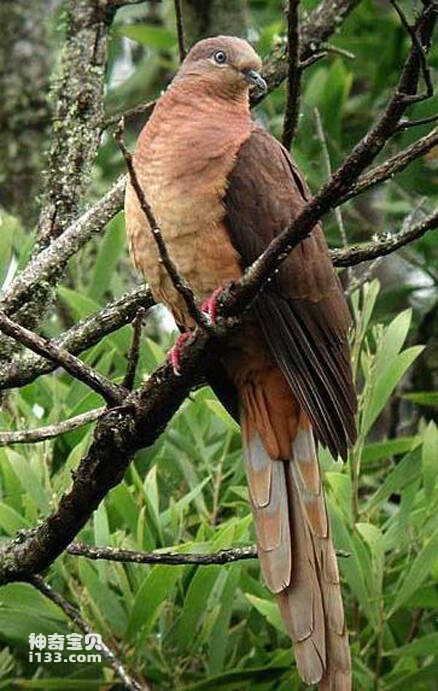Macropygia amboinensis
IUCN
LCBasic Information
Scientific classification
- name:Macropygia amboinensis
- Scientific Name:Macropygia amboinensis,Slender-billed Cuckoo-dove
- Outline:Landfowl
- Family:
Vital signs
- length:38-40
- Weight:107-179g
- lifetime:No textual research information is available
Feature
The back and tail are covered with black or brown markings
Distribution and Habitat
It is found in Indonesia and Papua New Guinea.
It is usually found in dense evergreen broad-leaved forests.
Appearance
The red thorax dove is 38-40 cm long and weighs 107-179 grams. It is larger than a cuckoo dove. The head, side and back of the neck are cinnamon russet or chestnut brown, with slight black lines, lighter plumage on the forehead, around the eyes and throat, and near black on the top of the head and pillow with a purplish-red sheen. The back, wings and tail feathers are dark chestnut brown, while the upper back and wings have a greenish-purple metallic sheen. The tail feathers are very long and the color is the same as the back, and the base of the two pairs of the outer tail feathers is rusty brown and has a faint black stripe. The underbody is rusty brown or cinnamon-brown, with faint dark brown lines. Chin and throat are light without spots. The flanks and abdomen are dark.
Blue iris, brown mouth, red base, red feet.
The plumage of male and female birds is generally similar. The body is relatively fat, the head is slightly smaller, the neck is thick and short, and the feathers a
Details
Macropygia amboinensis has 10 subspecies of Slender-billed Cuckoo-dove. It is a large brown cuckoo with a long tail. Red chest cuckoo doves and brown cuckoo bird used to be the same species, the name for "cuckoo bird", in 2014 as a subspecies of Macropygiaamboinensisphasianella independence, the name is still the cuckoo in brown dove ", while Macropygia amboinensis standard name in Chinese is "red chest cuckoo dove".

Red doves usually form small groups of 2-3 birds and rarely form large groups. Speed through the canopy. Land with your tail up. Temperament shy and timid, very afraid to see people, not easy to approach, flying wings vibration sound is very big. It mainly feeds on the fruits and seeds of various plants such as strawberries and breadfruit.
The breeding period is from April to July. Breeding in pairs. They usually nest in the thick branches of the forest. The nest is disc-shaped, mainly composed of thin dead branches, and each clutch lays 1 egg. The eggs are dark cream in color and are 23 mm x 19 mm in size.
Listed in the International Union for Conservation of Nature Red List of Threatened Species (IUCN) for 2016 ver 3.1 - Not Threatened (LC).
Protect wild animals and eliminate wild meat.
Maintaining ecological balance is everyone's responsibility!








